Kirkcaldy Corporation Tramways
Summary
Uniforms were late arriving, so for the opening of the system in 1903, and for a short time afterwards, staff simply wore informal attire. The new uniforms were perhaps worth the wait, as photographs suggest that they were of high quality, with the sleeves of conductors' jackets even being embellished with braid, something usually reserved for inspectors on other systems, and even then far from ubiquitously so. The uniforms comprised single-breasted jackets with five unmarked buttons (see link), two breast pockets (with button closures) and stand-up collars; the latter carried an employee number on the bearer's left-hand side and individual system initials — 'K C T' — on the right-hand side. It is currently unclear whether the badges were brass or nickel. The tensioned-crown peaked caps bore off-the-shelf, script-lettering grade badges, either 'Motorman' or 'Conductor'. The grade badges remained in use until the demise of the tramway in 1931, and for a short time after the end of the Great War were often supplemented with regimental or other military badges, with which the individual had presumably been associated.
Uniforms remained unchanged — stylistically — until the mid 1920s. After this, conductors continued to be issued with single-breasted jackets, but of a more modern cut with lapels and epaulettes (with button closures); motormen on the other hand were issued with double-breasted jackets with four pairs of buttons, and lapels. Neither style of jacket carried badges of any description.
Tramcar crews were also issued with long, double-breasted greatcoats with high, fold-over collars — once again, completely devoid of insignia.
In the early 1920s, inspectors were certainly wearing single-breasted jackets with black buttons (probably plain) and lapels, the collars bearing the grade — 'Inspector' — in embroidered script lettering; it is likely that this style of jacket was worn from the outset, though confirmation of this must await the discovery of photographic evidence from the earlier years of the system. The tensioned-crown peaked caps bore a hat band of a lighter colour (similar to those used on the nearby Wemyss system — see link), upon which the grade — 'Inspector' — was embroidered in script lettering. The style of jacket was changed in the mid 1920s to a double-breasted design virtually identical to those issued to motormen, and similarly without insignia. Inspectors were also provided with single-breasted overcoats which carried the grade, 'Inspector', on both collars in embroidered script lettering.
As with many tramway systems, Kirkcaldy employed women during the Great War to cover for tramwaymen lost to the armed forces, initially as conductresses, but subsequently as motorwomen, as well as an inspectress (a Miss Brown). Female staff were issued with long double-breasted coats with five pairs of plain black buttons, two waist and two breast pockets, high fold-over collars and epaulettes; the entire garment was devoid of insignia. A photograph has, however, survived of a conductress without the long coat, revealing the jacket worn underneath to have been single-breasted with two waist pockets, lapels and epaulettes, the entire ensemble once again devoid of insignia. Caps were initially in a baggy cloth style, sometimes called motor caps, but these were later replaced by issues identical to those worn by the men. Both caps carried standard, off-the-shelf, script-lettering grade badges. The lady inspector wore a uniform identical to female tramcar staff, but with an embroidered 'Inspector' badge on the cap, rather than the usual metal grade badge.
For a detailed account of the tramway, see 'The Tramways of Kirkcaldy' by Alan W Brotchie (N B Traction; 1978).
Images
Motormen and conductors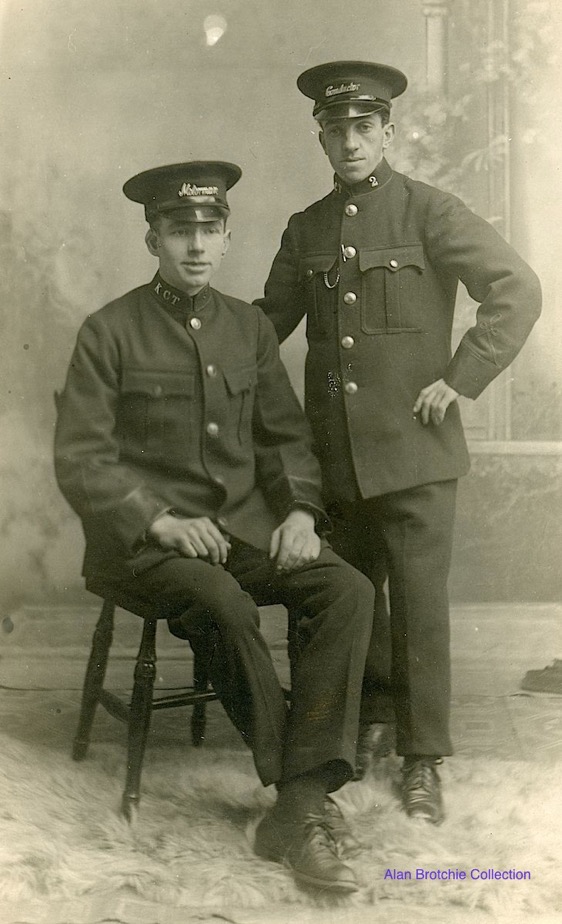
An excellent studio portrait of Kirkcaldy Corporation Tramways motorman J. Gillies (Employee No 5) and his conductor, A. Balfour (Employee No 2). Photo undated, but given that this is a studio portrait, the employee numbers are low, and the uniforms look to be pristine, it seems highly likely that it was taken around the time of opening (1903). Note the braiding above Conductor Balfour's cuff, an elaborate adornment normally reserved for inspectors on other systems.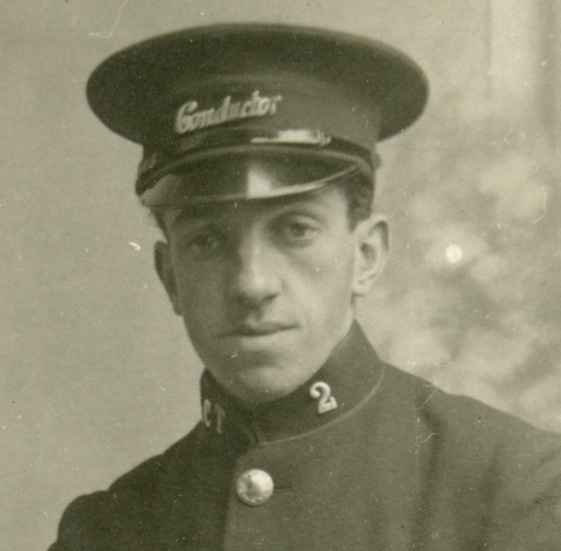
An enlargement of the above photograph showing details of the conductor's uniform, including the plain, scalloped-rim buttons (see link).
General pattern script-lettering cap badges — 'Motorman' and 'Conductor' — of the type used by Kirkcaldy Corporation Tramways. It is currently unknown whether Kirkcaldy used brass or nickel badges.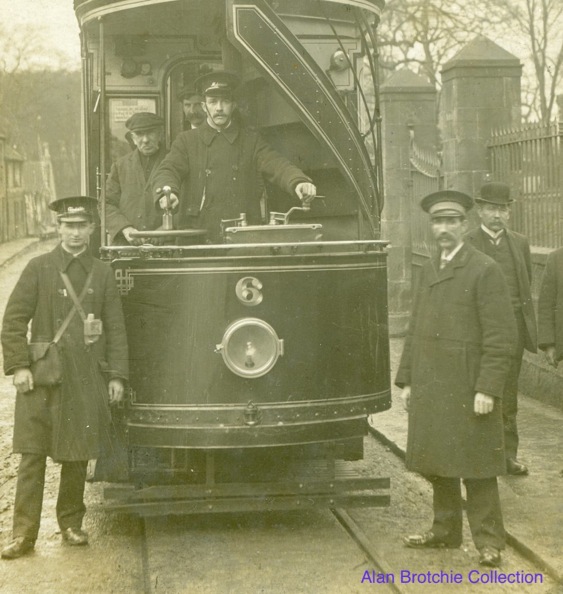
The crew of Tramcar No 6 pose at the Dysart terminus with Inspector Kidd, not long after the opening of this section (1911).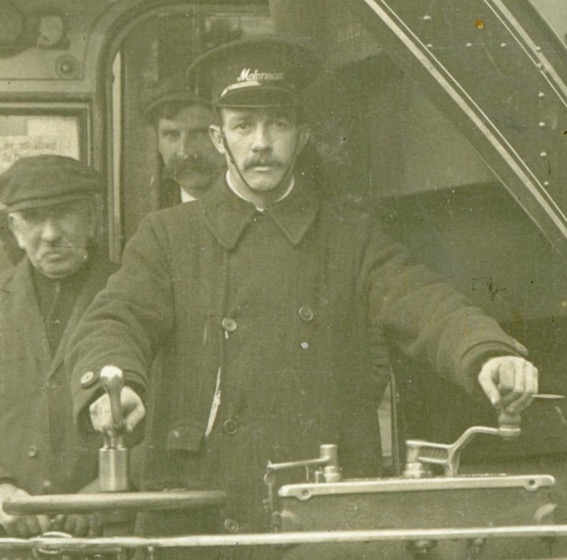
An enlargement of the above photograph showing the motorman, who most unusually has an additional chin strap, which he is using as a chin strap, the vast majority of tramwaymen being content to have just the one chin strap as a decorative adornment above the peak. The greatcoat is completely devoid of insignia, including the buttons, which appear to be black horn.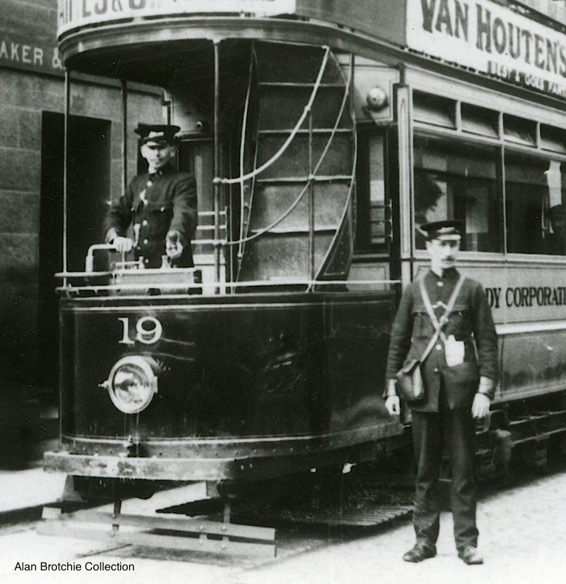
The crew of Tramcar No 19 at Links Street terminus — photo undated, but probably taken in the years before the Great War.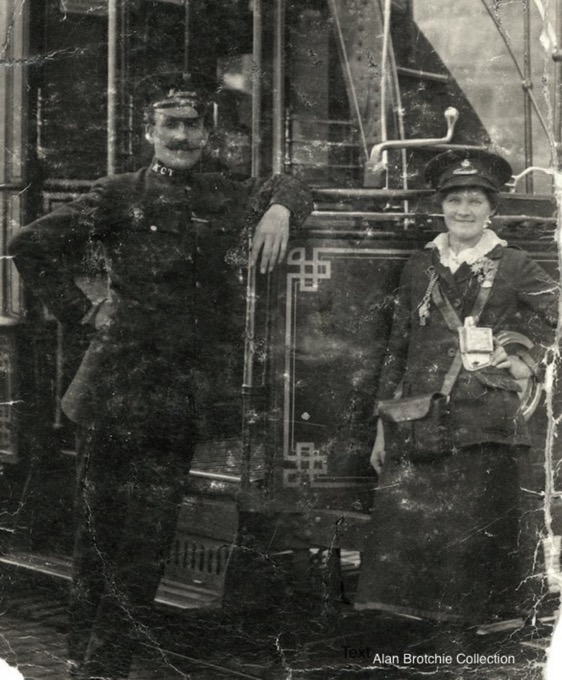
A motorman and a conductress — photo undated, but probably taken during the Great War or shortly afterwards.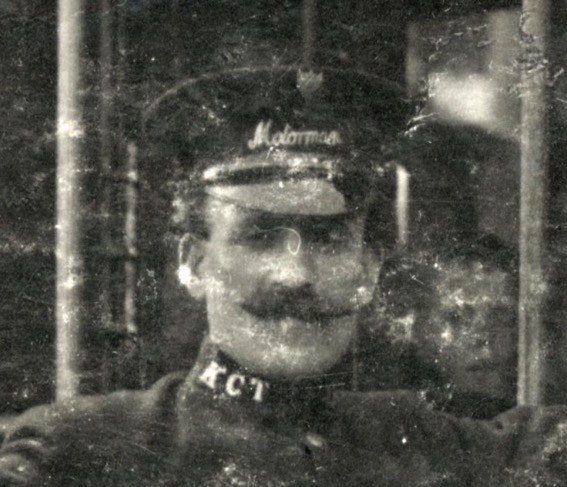
An enlargement of the above photograph, which clearly shows the motorman to be wearing a scalloped-topped, shield-shaped badge above his grade badge. This was almost certainly a military badge, possibly that illustrated below.
A Kirkcaldy Volunteer Motor Transport Corps badge, probably of the same pattern worn by the motorman in the preceding photo.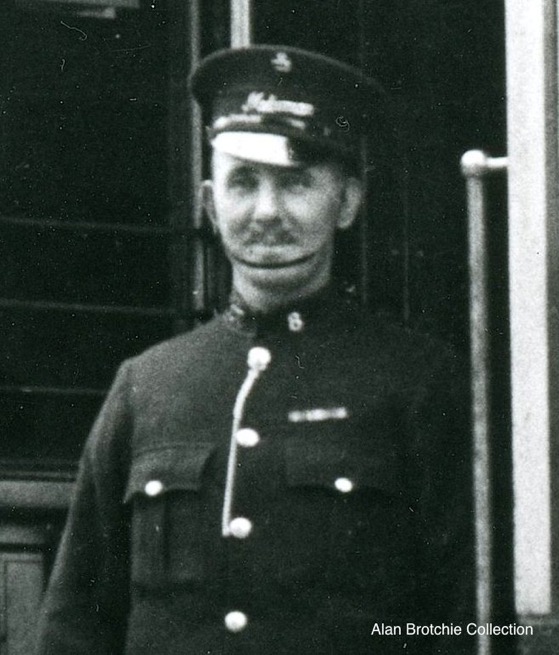
A motorman (Employee No 8) aboard the front platform steps of Tramcar No 24 — photo undated, but given the style of uniform and the medal ribbon, probably taken shortly after the Great War. Given that the subject is wearing an additional chinstrap under his chin, it is tempting to wonder whether he is the same man doing likewise in the earlier shot. He is also wearing a small badge above the standard grade badge, almost certainly military in origin, but not the same shape as the Kirkcaldy Volunteer Motor Corps badge.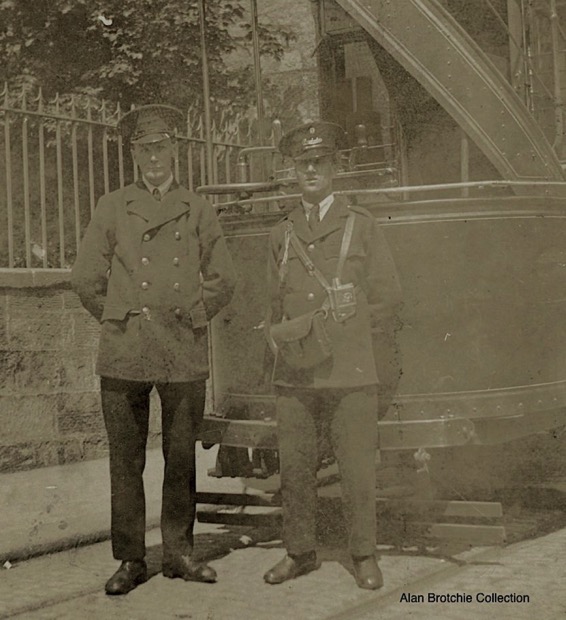
An inspector and a conductor with an unidentified tram at the Dysart terminus looking east — photo undated, but probably taken in the mid 1920s. Note the new style of uniforms with lapels.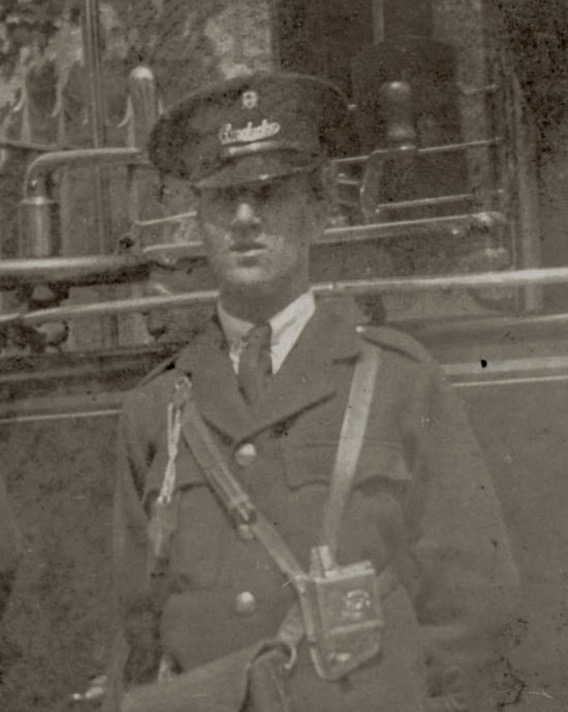
An enlargement of the above photograph showing details of the conductor's uniform, including yet another small cap badge above his grade badge; the latter is also underlined, a pattern that was not a commonly used on British tramways.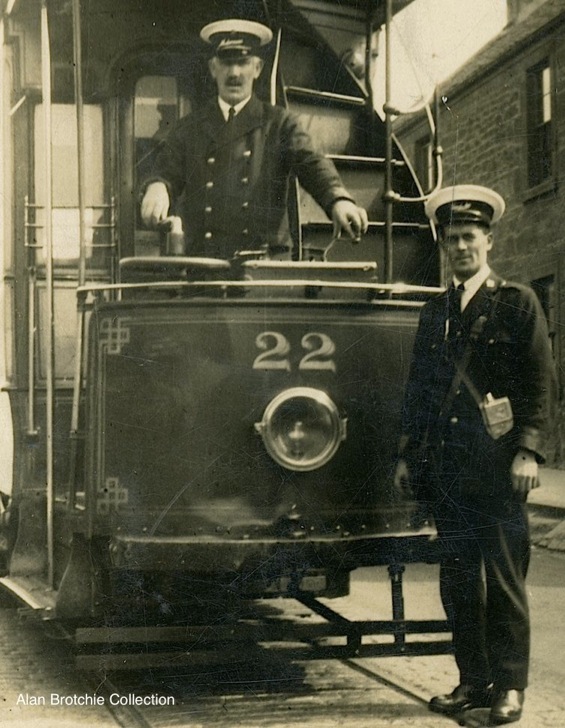
The crew of Tramcar No 22 pose for the cameraman near the Gallowtown terminus — photo undated, but probably taken in the late 1920s or early 1930s.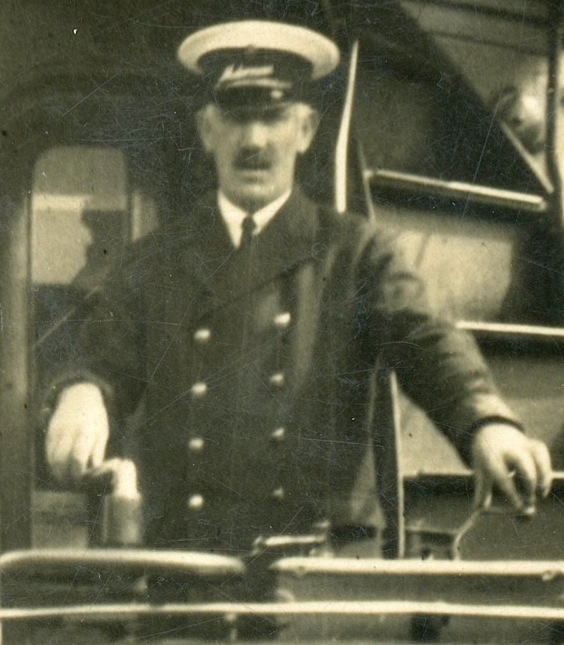
An enlargement of the above photograph showing the motorman, who is clearly wearing a small badge above his grade badge.
Senior staff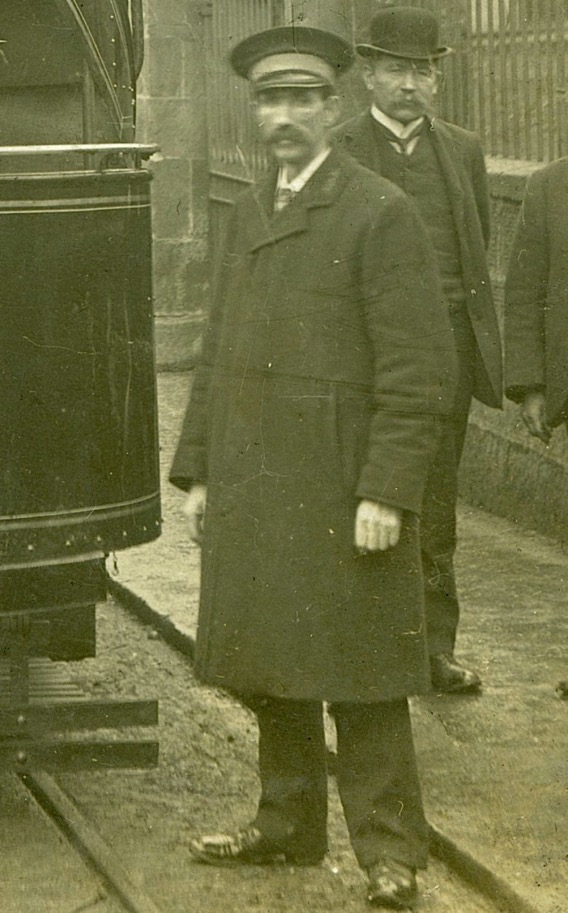
An enlargement of the Dysart photograph above showing Inspector Kidd — circa 1911. Although blurred, it does show the light-coloured hat band and the embroidered 'Inspector' badges on the collars.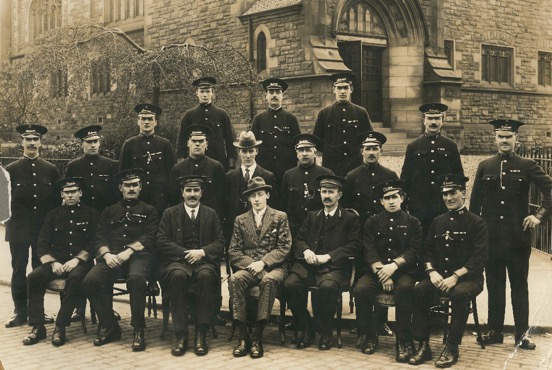
A staff photograph which, judging by the medal ribbons and the trilbies, was almost certainly taken in the early 1920s. The two inspectors — seated either side of the dapper gentleman on the front row, are wearing single-breasted jackets with the usual grade designation embroidered on the collars.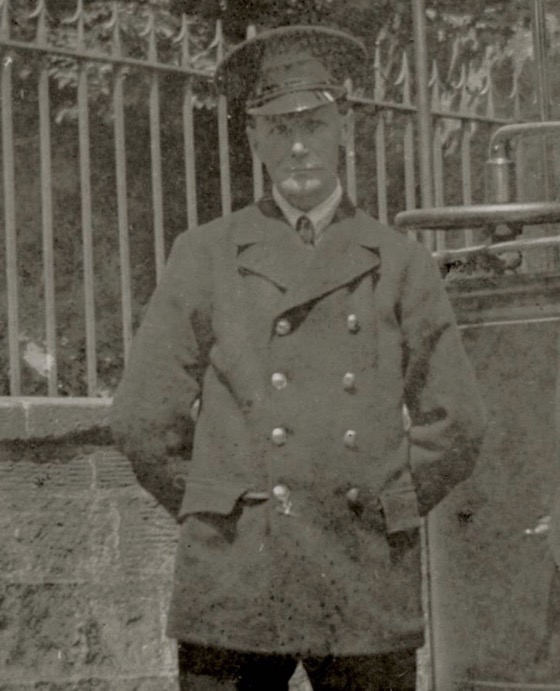
An enlargement of one of the earlier photographs above showing a 1920s inspector in double-breasted jacket with lapels. With thanks to Alan Brotchie.
Female staff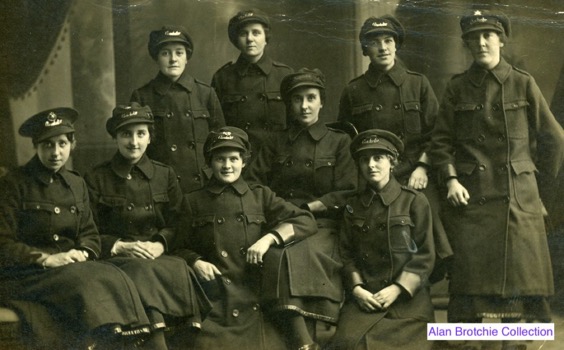
A studio portrait of eight Kirkcaldy Great War conductresses and a lady inspector.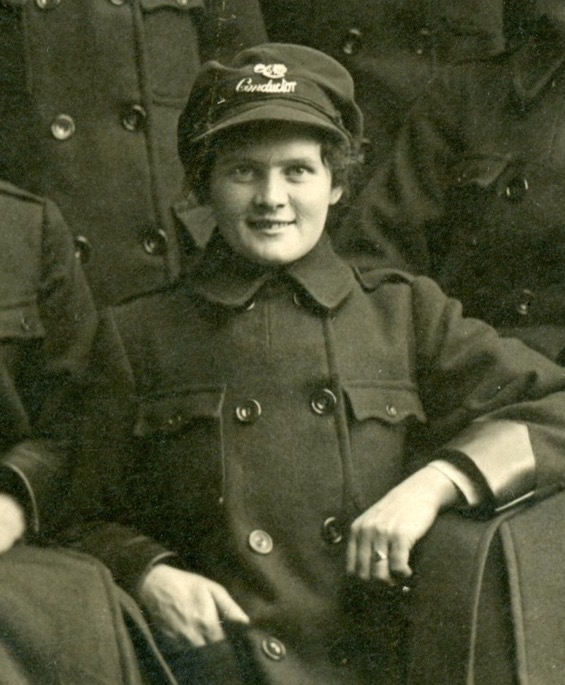
An enlargement of the above portrait showing one of the conductresses. Save for the cap, the uniform is completely devoid of insignia. The cap carries a standard script-lettering grade cap badge, above which is almost certainly a regimental sweetheart badge, a common means of showing support for a loved one away with the armed services.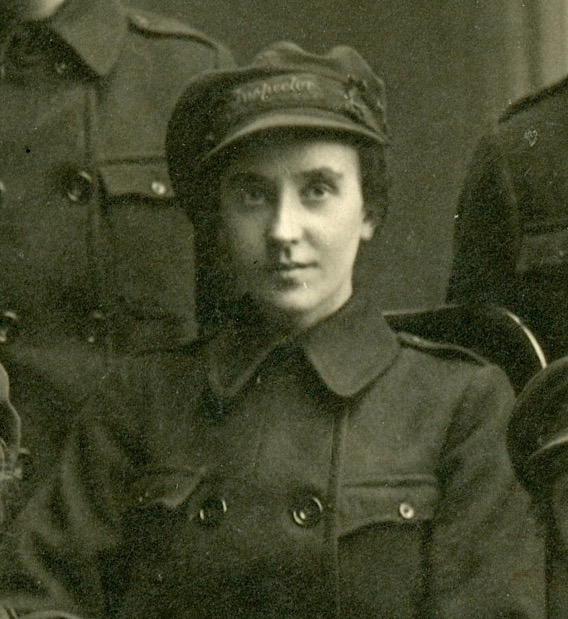
Another blow-up of the staff photo above showing the lady inspector, almost certainly Miss Brown. The style of coat is identical to that worn by the conductresses, as is the baggy cap, though this clearly carries an embroidered 'Inspector' badge.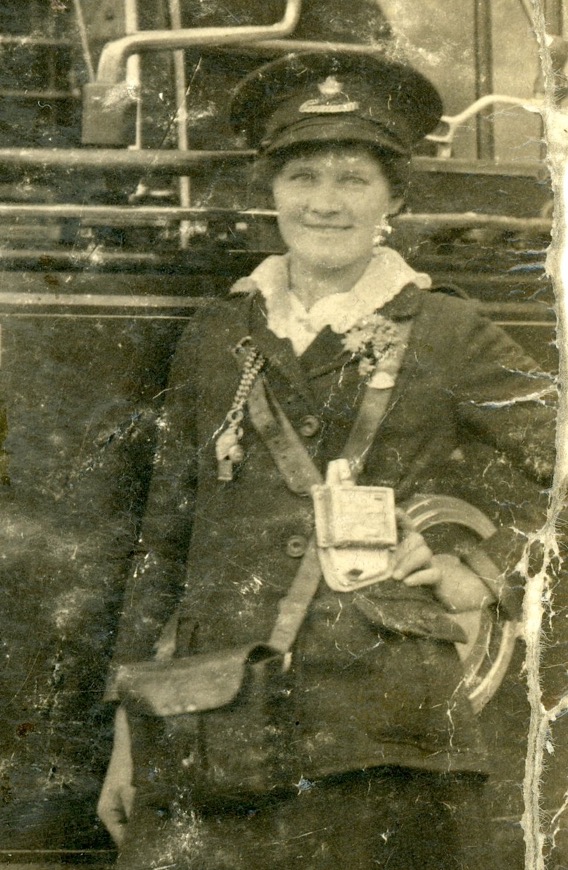
An enlargement of the earlier crew photograph showing a conductress in a uniform jacket rather than long topcoat. The cap badge is almost certainly a regimental sweetheart badge.